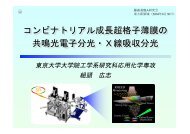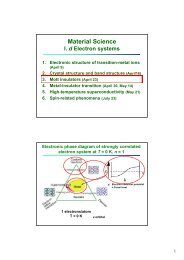Thesis High-Resolution Photoemission Study of Kondo Insulators ...
Thesis High-Resolution Photoemission Study of Kondo Insulators ...
Thesis High-Resolution Photoemission Study of Kondo Insulators ...
Create successful ePaper yourself
Turn your PDF publications into a flip-book with our unique Google optimized e-Paper software.
6.3. Results and Discussion 85<br />
distribution function. Thus we again divided the spectra by the FD function (convoluted<br />
with a Gaussian corresponding to the energy resolution) as shown in the lower<br />
panel <strong>of</strong> the figure. The spectral DOS thus obtained is found to increase with increasing<br />
temperature in a rather wide energy region between EF and ∼−100 meV.<br />
Intensity<br />
DOS<br />
LuB 12<br />
hν = 21.2 eV<br />
300 K<br />
225 K<br />
150 K<br />
75 K<br />
7 K<br />
300 K<br />
225 K<br />
150 K<br />
75 K<br />
7 K<br />
LuB 12<br />
-150 -100 -50 0 50 100<br />
Energy relative to E F (meV)<br />
Figure 6.6: Temperature-dependent He I photoemission spectra <strong>of</strong> LuB12 (upper panel)<br />
and those divided by the FD function convoluted with the instrumental resolution<br />
(lower panel).<br />
We note again that the intensity at EF in the spectra divided by the convoluted<br />
FD function does not depend on uncertainties in the temperature nor the Gaussian<br />
width, because the FD function is 0.5 at EF at any temperature even if that FD<br />
function is convoluted with any Gaussian. However, an error in the temperature or the<br />
Gaussian width might cause a spurious temperature dependence near EF in the FDfunction-divided<br />
spectra. The fact that temperature dependence is more remarkable






